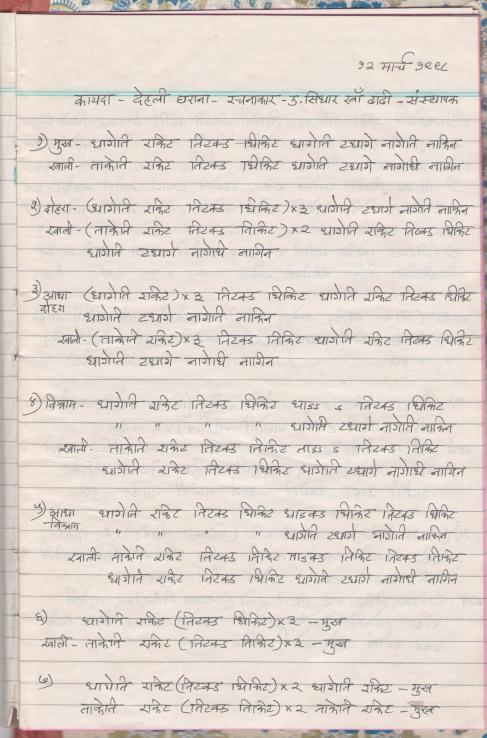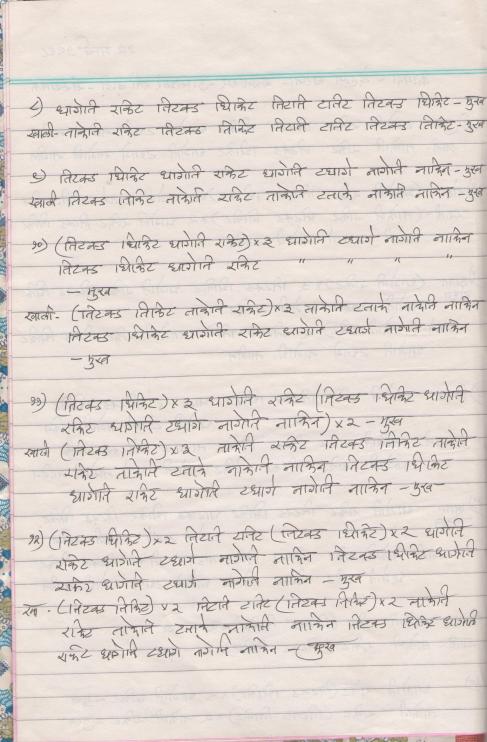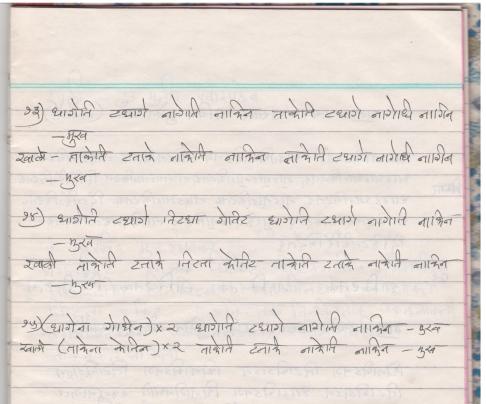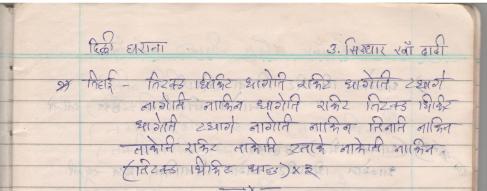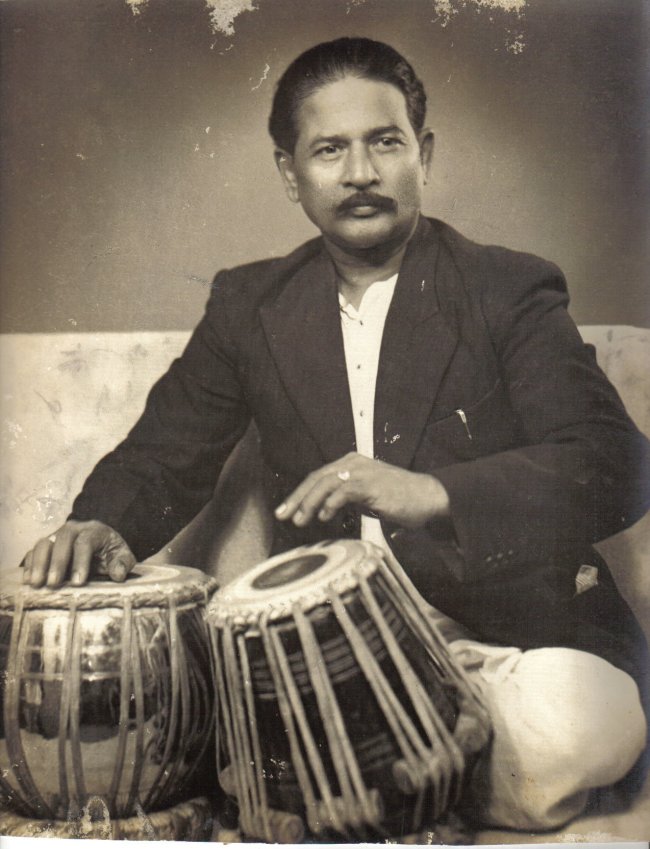Few thoughts on Kaida
It is a well known fact that a typical Tabla Solo performance has the following elements to a certain degree as per the performer’s Taalim, Understanding, Riyaaz & thought process. It goes without saying that the style of Tabla playing i.e. his Gharana will definitely weigh upon his preference of choosing the material for presentation.
1 Peshkar
2 Kaida
3 Rela/ Chalan/ Rav
4 Gat/ Tukda/ Chakradhaar
I want to share my thoughts on the Kaida in this write up.
Kaida (Qaeda) is a word of Arabic origin. “Al-Qaeda” has different meanings, among them “Base”, “Ground”, “Norm”, “Rule”, “Fundament”, “Grammar”. The exact meaning is dependent on the context in which it is used. Almost all the meanings apply when we discuss Kaida of Tabla. Though it has been widely accepted that Kaida means Rule, in my opinion it does not fully grasp what Kaida is all about. Yes a certain Kaida is a certain Rule to play a specific Bol or specific phrase. But Kaida does not mean only that, it has its own grammar like Kaida has to be a structured composition showing distinct Khali Bhari. There are quite beautiful exceptions in some Ajarada Kaida as they do not have an exact Mirror image of Bhari & also there is no development of Khali section if we consider Kaida to be divided into 8+ 8 = 16 format. If time permits I will post a Ajarada Kaida of this feature. The Bols of Kaida are Tita, Titakda Dhikita, Tirakit, Kit Tak, DhirDhir etc., so by practising Kaida one learns, understands & polishes the fundamentals of Tabla by extension. There is norm to develop/play Kaida, one must never use any Bol outside the Kaida (Mukh). As far as possible one should not change the structure of the composition during development. One can easily draw parallel to this to singing a certain Rag (Outside Swara is not allowed & sequence/distance between 2 Swara’s needs to be maintained.). A Tabla student will immediately grasp how the meaning of Base is perfect for Kaida as the practice of a certain Bol can only be done by practising Kaida.
Amir Hussain Khansaheb used to say that “The Stamina can only be built through practice of Kaida by observing Chilla. I have copy-pasted meaning of Chilla from Wikipedia for better understanding.
Chilla-nashini (Persian: چله نشینی) is a spiritual practice of penance and solitude, known mostly in Indian and Persian traditions. In this ritual a mendicant or an ascetic attempts to remain seated in a circle without food, water, or sleep for 40 days and nights. The word ‘chilla’ is adopted from the Persian word ‘chehel’, meaning ‘forty’. The nashini is the person who does the 40-day fast and remains seated in the circle of seclusion. It is believed that those who try it but do not succeed usually die or suffer madness.
Of course the concept is modified in practice of Tabla, as the student does not seek to speak to God but to do Akshar Sadhana. I have chosen this word as it not only perfectly describes what one does while observing Chilla, but was used by Amir Hussain Khansaheb while stressing the need of Akshar Sadhana if one wishes to play with the same vigour even in his old age. The same has been exemplified by Ahmedjaan Thirakwasaheb, Amir Hussain Khansaheb & Habibuddin Khansaheb as well. Afaq Hussain Khansaheb has also recommended practicing Kaida, by saying if Kaida is practiced by understanding it properly then there will be refinement (Nafasat), better assimilation of knowledge (Ilm) among other things.
A small note here would not be out of context: when we say Kaida, it is normally understood that one is talking about Teentaal. Most, if not all of the old compositions have been composed in Teentaal & it is my inherent belief that Tabla Solo means Teentaal. There can be other Taals but it is just for the sake of variety or in recent times to show off one’s arithmetical prowess.
Normally development of Kaida is expected to be done in an orderly manner. I have scanned below a Kaida by Siddhar Khansaheb Dadhi, the founder of Delhi Gharana. It may be noted that this Kaida is not a very straight forward composition & can be expanded in terms of Tirakit as well as Titakda Dhikit. Secondly it is in Tishra Jati. Due to its beautiful structure, as well as melodious sound production this is a Kaida which can be played in regular concerts & need not be limited to practice sessions only.
This brings to fore the question of how far a Kaida can be expanded in a concert. I would prefer one or two well developed Kaidas instead of shabby treatment to 4 – 5 Kaidas as is done nowadays to show off the repertoire of material.
I have learnt the typical expansion of Kaida as below:
Mukh, Dohra, Adha Dohra (Optional), Vishram, Adha Vishram (Optional), Bal, Palta to be concluded by Tihai.
Mainkarji in his book explains additional types like Pench, Fandah & Girah:
I have tried to loosely translate the terms. Pench is the question arising during development, Fandah is the situation from where it is difficult to get back to the track of Kaida & Girah is almost out of context to Kaida.
May be this terminology is used exclusively in Delhi Gharana & hence not too commonly known & hence the novelty. As per Afaq Hussain Khansaheb, Bal & Pench is the same, just different terminology used by different people. As per Guruji, ‘pench’ should always be followed by simple ‘Bal’ so that listener can savour the change in thought process. Of course it goes without saying that all the variations are accompanied by Mukh.
I have taken references from various recordings of Amir Hussain Khansaheb, Afaq Hussain Khansaheb, Guruji’s book “Tabla (in Marathi) & Sudhir Mainkarji’s book, “Tabla –Kala Aur Shastra”. Apart from the old masters whom I will remain indebted to forever, I am in equal debt if not more to my Guruji, (Arvind Mulgaonkar) who has taught me very patiently & lovingly in spite of my obvious deficiencies.
I am also grateful to Shri James Kippen for his painstaking work in Lucknow. I have referred the recording he made during his stay there, available on British Archives for listening.
It should be noted that all the names need to be read with honorific Khalifa or Ustad or Pandit as the case may be. I have not mentioned these titles as it affects the flow.

